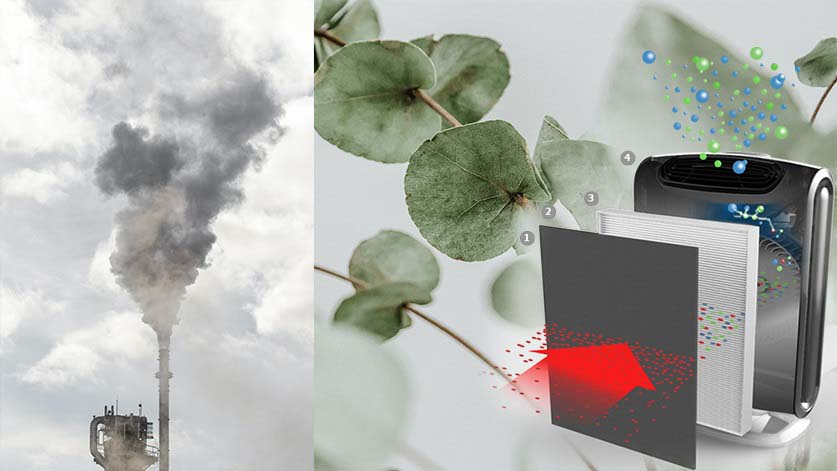
QUALITY AIR WITH AIR PURIFIER
Indoor air pollutants are unwanted, sometimes harmful materials in the air. Indoor air pollution is among the top five environmental health risks. Usually the best way to address this risk is to control or eliminate the sources of pollutants, and to ventilate a home with clean outdoor air.
We are increasingly aware of the importance of breathing clean and pure air. Poor air quality significantly affects peo¬ple’s health and performance, with fatigue and respiratory problems being amongst the most common problems.
-
Particulate Matter includes dust, smoke, pollen, animal dander, tobacco smoke, particles generated from combustion appliances such as cooking stoves, and particles associated with tiny organisms such as dust mites, molds, bacteria, and viruses.
-
Gaseous pollutants come from combustion processes. Sources include gas cooking stoves, vehicle exhaust, and to-bacco smoke. They also come from building materials, furnishings, and the use of products such as adhesives, paints, varnishes, cleaning products, and pesticides.
Particle Removal Two types of air cleaning devices can remove particles from the air—mechanical air filters and electronic air cleaners. Mechanical air filters remove particles by capturing them on filter materials. High efficiency particulate air (HEPA) filters are in this category. Electronic air cleaners such as electrostatic precipitators use a process called electrostatic attraction to trap charged particles. They draw air through an ionization section where particles obtain an electrical charge. The charged particles then accumulate on a series of flat plates called a collector that is oppositely charged. Ion generators, or ionizers, disperse charged ions into the air, similar to the electronic air cleaners but without a collector. These ions attach to airborne particles, giving them a charge so that they attach to nearby surfaces such as walls or furniture, or attach to one another and settle faster.
Gaseous Pollutant Removal Gas-phase air filters remove gases and odors by using a material called a sorbent, such as activated carbon, which adsorbs the pollutants. These filters are typically intended to remove one or more gaseous pollutants from the airstream that passes through them. Because gas-phase filters are specific to one or a limited number of gaseous pollutants, they will not reduce concentrations of pollutants for which they were not designed. Some air cleaning devices with gas-phase filters may remove a portion of the gaseous pollutants and some of the related hazards, at least on a temporary basis. However, none are expected to remove all of the gaseous pollutants present in the air of a typical home. For example, carbon monoxide is a dangerous gaseous pollutant that is produced whenever any fuel such as gas, oil, kerosene, wood, or charcoal is burned, and it is not readily captured using currently available residential gas-phase filtration products.
Pollutant Destruction Some air cleaners use ultraviolet (UV) light technology intended to destroy pollutants in indoor air. These air cleaners are called ultraviolet germicidal irradiation (UVGI) cleaners and photocatalytic oxidation (PCO) cleaners. Ozone generators that are sold as air cleaners intentionally produce ozone gas, a lung irritant, to destroy pollutants.
Increased respiratory ailments (bronchiolitis, rhinopharyngitis, bronchial hypersecretions);
Degradated ventilator function (lower breathing capacity, asthma, coughing)
Eye irritation;
Increased cardiovascular morbidity;
Depleted immune system;
Impact on short-term mortality due to respiratory and cardiovascular diseases;
Impact on long-term mortality linked to the carcinogenic effect of pollutants.
- Power up your New Ventilation system and give us a feedback.
Indoor Air Pollutants
Pollutants that can affect air quality in a home fall into the following categories:
What Types of Pollutants Can an Air Cleaner Remove?
Health Effects of Air Pollution
Several studies show the association between air pollution and several adverse health effects in the general population. These effects range from subclinical effects to premature death, and include notably the following consequences:
Who needs Air Purifier?
Due to the level of pollution in our environment, every household, office, event centre, schools and worship centres needs, Air Purifier for better indoor air quality.
Can Air Purifier Cure Covid19?
Air Purifier has not been proven to cure Covid19, but it can prevent you from being exposed to other respiratory irritants.
Where can I get Air Purifier?
Speak to one of our agents online or send us an email. We will respond as soon as possible.
If we didn't answer your question, Please chat with one of our agents or send us an email. Thank You.
REQUEST A QUOTE NOW!

Air pollution is a major cause of non-communicable diseases. It is estimated that at least 3% of cardiopulmonary and 5% of lung cancer deaths are attributable to PM globally. The most recent study on the Global Burden of Disease estimates that 7.5% of deaths globally were attributable to ambient air pollution in 2016. In the same year, 27.5% of deaths due to Lower Respiratory Tract Infections and 26.8% of deaths due to Chronic Obstructive Pulmonary Diseases were linked to air pollution. This chapter will review the impact of air pollution on the major sources of deaths globally.
Let M.E help you with IAQ solutions.
Mekanik Elektrik is the leading re source for all things heating, cooling, and indoor air quality online. We offer a variety of free resources to help you understand and best care for your HVAC systems and components. When you need individualized help for your home’s equipment, use our HVAC Contractor Directory to locate a nearby HVAC company to assist.





Comments (2)
Posted by: Admin
10 March, 2021When you need individualized help for your home’s equipment, use our online form, chat or give us a call.
ReplyPosted by: Admin
10 March, 2021Mekanik Elektrik is the leading resource for all things heating, cooling, and indoor air quality online. We offer a variety of free resources to help you understand and best care for your HVAC systems and components.
Reply